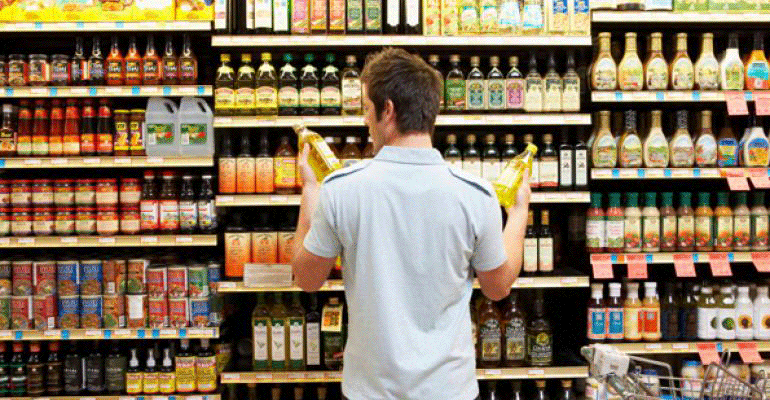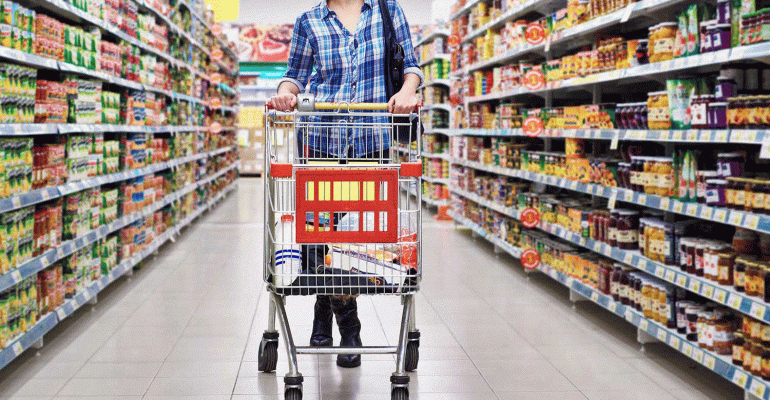Though 2017 was a comeback year for private label retail sales, grocery stores have seen some of that business siphoned away by other retailers, new research from the Food Marketing Institute and IRI reveals.
U.S. private-label sales rose 4.1% to $138 billion last year across multiple retail outlets, according to the FMI-IRI report “Power of Private Brands,” released this week. That compared with a 1.3% uptick to $929 billion for all brands.
Yet in the grocery retail channel, private label sales dipped 0.1% to $68 billion versus an 0.5% increase to $413 billion for all brands. In 2017, private brands accounted for 16.4% of dollar sales in the grocery channel and 14.8% in the multi-outlet space.
The data covers edibles, non-edibles and perimeter sales by food, drug, mass and convenience stores, plus select club and dollar retailers and military commissaries.
FMI and IRI said private label food and beverage sales at supermarkets have rebounded since the second half of 2014, when an overall decline in dollar sales showed private brand volume dropping noticeably more than national brands. Private label began a sharp upturn in the 2016 third quarter that, a year later, put own brands in the grocery channel “within striking distance of national brands for the first time in years,” the report noted.

However, the resurgence was much stronger for private brands in multiple retail outlets, where private label’s growth rate for food and beverages well exceeded that of national brands as 2017 drew to a close. This indicates that other retail channels have been seeing more success with private label than supermarkets, the study said.
“Private brand performance within the grocery channel shot up dramatically in the past year. Retailers made considerable progress not only in reversing sales declines, but in closing the gap with national brands, supported by a reduced sting from deflation,” the report explained. “But the news wasn’t all positive. Retailers outside of the grocery channel — including mass and club operators — have been performing much better in private brand. Supermarkets face major competitive challenges and are experiencing steady own-brand share leakage to other retail channels.”
Indeed, in the U.S. multi-outlet channel, private label sales for edibles rose 1.6% in the 52 weeks ended Sept. 24, 2017, compared with 0.3% for national brands and 0.6% for overall food and beverage sales. For the grocery channel, though, private brand consumables sales fell 2.7%, compared with an 0.5% gain for national brands and an 0.1% dip for total edibles dollar volume.
The decline was even more precipitous in the drug channel, where private label dollar sales for food and beverages sank 11% versus decreases of 2.1% for national brands and 3.1% for all brands.
“Trips per buyer are down in the grocery channel,” FMI and IRI said in the report. “Moreover, this trend has impacted private brand trips more than the rest of the store. Where are these trips going? Most likely they are going to other retail channels, such as mass and club. This fact further underscores the challenges to grocery retailers from other retail sectors.”
One contributing factor may be a misalignment between private brand tiers and consumer economics, the study suggested.
For example, in the grocery channel, 52% of private label dollar share is in the mainstream tier, compared with 24% for the premium tier, 18% for the value tier and 6% for the organic tier (approximately the same percentages going back to 2015). Yet a third of the U.S. population struggles to afford groceries, and organic and premium products — most likely to be purchased by higher earners — represent about 30% of private brand sales.
Moreover, organic holds an outsized — and growing — share in private label. Private brands account for about 20% of food and beverage sales overall but represent 30% of all organic items.
Consumer income disparities may move the industry further away from the middle tier (mainstream) and more to the upper (premium and organic) and lower (value) tiers, FMI and IRI noted in the report.
“While the news for private brands overall is good, there is a special hurdle for food retailers,” said Mark McKeown, principal of client insights for IRI. “We needed to uncover why the biggest growth is taking place outside the grocery channel.”
FMI and IRI’s consumer research found that 97% of U.S. households buy store brands. Fifty-one percent are medium buyers of private label (26% to 75% of purchases), 40% are light buyers (25% or less of purchases) and 9% are heavy buyers (76% or more of purchases).
In addition, 69% of consumers said it’s “very” or “somewhat” important to have a good assortment of private brands in food and beverages.
“Private brands have become full-fledged brands in their own right, and the research emphasizes the importance of not making assumptions when appealing to demographics and audiences, including how store brands are marketed and positioned,” said Doug Baker, vice president of industry relations for FMI. “In fact, Generation X is responsible for 31% of all dollars spent on private brands across all outlets, compared to 19% each for older Millennials and younger Boomers.”





